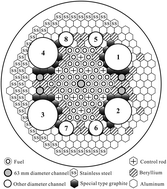Sample neutron irradiation with the Min Jiang Testing Reactor (MJTR): implications for high-precision 40Ar/39Ar dating†
Abstract
The Min Jiang Testing Reactor (MJTR) is a new irradiation facility for 40Ar/39Ar geochronology. In this study, we systematically evaluated the neutron flux field gradients of the MJTR for irradiation of samples for 40Ar/39Ar dating and yielded an average neutron flux equivalence of 0.21 × 10−4J h−1 over the neutron irradiation process. The vertical and the horizontal gradients are down to 0.68% cm−1 and 0.45% cm−1, respectively, indicating a sufficiently wide neutron flux stabilization field for 40Ar/39Ar sample irradiation. The production rate ratios of interfering reactions are (36Ar/37Ar)Ca: 4.17 ± 0.07 × 10−4, (39Ar/37Ar)Ca: 18.4 ± 3.6 × 10−4, and (40Ar/39Ar)K: 146.5 ± 42.4 × 10−4, within the range of other nuclear reactors worldwide. The J value error can be estimated to be <1‰ (1sd) when the sample is placed close to the irradiation thimble center. Four aliquots of DRA-1 yield a consistent intercalibration factor between ZBH-25 and DRA-1 with an average of 0.183061 ± 0.000432 (1sd, 2.4‰), indicating that the MJTR is suitable for high-precision 40Ar/39Ar sample irradiation.



 Please wait while we load your content...
Please wait while we load your content...